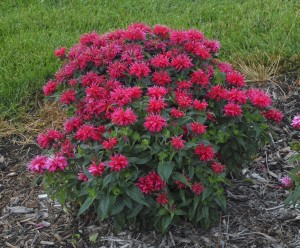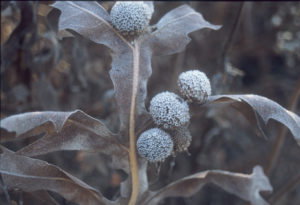Even though the grasses of the prairie are drying up and seed heads are ripening, creeping quietly beneath it all is bee balm – still green and growing. I have stumbled on to quite a bit of it around our grounds as I begin to hang Christmas lights through the gardens. I can tell when I am tromping through a patch of bee balm because of the fresh, minty smell the crushed leaves exude. Extremely hardy and adaptive, monarda species stay green long into fall and early winter. Bee balm is a timeless prairie flower, and an excellent performer in the landscape.
Here are some tips to getting the most from your Monarda!
Know Before You Grow
Though bee balm is quite adaptable, each species has its preferences and will thrive in specific environments. Monarda fistulosa, for example, is native to much of North America and thrives in full to part sun conditions. You may have heard this plant referred to as wild bergamot or Oswego tea. This is the species you are most likely to find in the prairies of eastern Kansas. Monarda didyma, however, prefers a much shadier and protected environment. This type of bee balm is native to eastern regions of the US and cannot handle our full Kansas sun. There are countless varieties of bee balm, specially made to fit any color scheme or garden space. Just be sure to check the parentage of the cultivar to know what its true growth habits are.
Not Just For Bees
As I mentioned earlier, Monarda species often have common names that refer to its culinary use. It is sometimes called wild bergamot because of its aroma, reminiscent of bergamot orange oil in Earl Grey tea. The use of bee balm as a tea has a long history within the nations of Native Americans, for its pleasant taste and medicinal properties. I have personally had tea made from bee balm growing right here on the Arboretum grounds, and I love the warm, spicy flavor. I have even seen people use the flowers as cake decorations and in salads! Do your research and be sure you have edible species of bee balm growing in your garden before you decide to make any herbal concoctions of your own.
The Mildew Dilemma
One of bee balm’s fatal flaws is its tendency to contract powdery mildew. This is a fungal disease that causes the leaves to look as if they have been dusted with powdered sugar. This affliction causes leaves to twist and break off, and can lead to quite a bit of defoliation. It usually doesn’t harm the health of the plant, but can make it look a little sickly through the growing season. There are lots of ways to treat this issue, from conscientious watering to chemical options, as well as low-cost low-impact homemade remedies. Even though Monarda is so susceptible to this disease, it still stays in my top list of landscape plants because of its floriforus habit, aromatic leaves and pollinator attraction. As you see in the photo above, it even looks nice in the winter when the globe-shaped seed heads make their debut!



